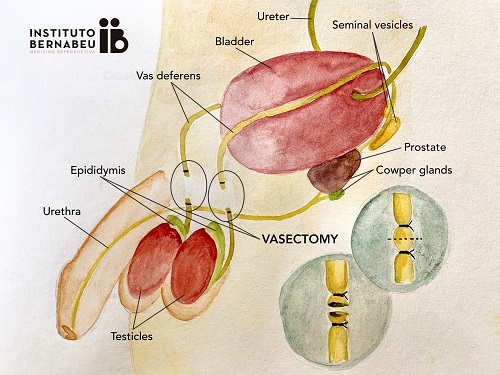
How to be a parent after vasectomy?
Vasectomy acts as an obstructive azoospermia which means it achieves the absence of spermatozoa and spermatogenic cells in the sperm and urine after ejaculation, due to a bilateral obstruction of the seminal ducts.
It is an effective method of permanent male surgical sterilization. However, at the present time, pregnancy can be achieved after vasectomy.
Índice
Before you have your vasectomy, you should discuss the following points:
Its definitive character, implies that before its realization you must receive an exact information about its risks and benefits:
- Vasectomy should be considered irreversible.
- It is followed by a low rate of complications; however, however, as it is a programmed operation, even small risks need to be explained, as men (and their partners) may wish to consider them before giving consent.
- Vasectomy can fail, although the failure rate is low.
- Couples should be advised to continue with other efficient contraceptive methods until sperm clearance is confirmed.
- It does not prevent the spread of sexually transmitted diseases.
- All available data indicate that vasectomy does not have serious long-term side effects.
- Among the different processes; vasectomy consisting of fascial interposition with cautery seems to be the most efficient technique.
Sprem collection for in vitro fertilization after vasectomy
There are several successful techniques for obtaining sperms directly from the testicle. This allows you to have offspring after vasectomy:
- At Instituto Bernabeu we use a technique of sperm retrieval that consists of the aspiration of testicular tissue with a fine needle (Testicular sperm aspiration (TESA). Unlike testicular biopsy, this technique it is done with local anesthesia and it´s not necessary to open the scrotal sac nor losing fragments of testicular tissue. Therefore is a simple, minimally aggressive, fast and successful method that can be repeated for several cycles of in vitro fertilization.
- Testicular biopsy, due to its greater aggressiveness, is not the technique of choice at Instituto Bernabeu. More information
In case of men who already had children, sperm collection by this technique is close to 100%, making the need for a testicular biopsy very rare. (not to be confused with successful assisted reproduction cycle). Many years after having a vasectomy, even more than 16 years after its performance, useful sperm are easily obtained.
Once the sperms have been collected, they are transferred to the in vitro fertilisation laboratory to inseminate the previously collected eggs by use of ICSI.
Vasectomy Correction: Vasovasostomy

It should be noted that about 2-6% of men who have had a vasectomy request a vasectomy rectification. The technique to rectify it is called Vasovasostomy and is the opposite process to vasectomy:
It consists of restoring the union of the vas deferens that was sectioned when the vasectomy was performed, to allow the passage of sperm again. To do this, the uroandrologist uses microsurgical techniques with the help of a surgical magnifying glass and smaller suture materials.
A large variety of surgical success rates for vasectomy correction have been published (up to 90 %); success depends on
- The time between vasectomy and re-fertilization.
- Type of vasectomy performed (e.g., open-ended or closed-ended).
- The mode of correction (vasovasostomy or vasoepidymostomy).
- And if the correction was unilateral or bilateral.
Limitations of Vasovasostomy
The technique has several inconveniences:
- After it is performed, you have to wait 8-12 months to see if enough spermatozoa are produced in the ejaculate again.
- The success of the operation does not guarantee that functionality will be recovered. It is not always possible to restore sperm production in a sufficient quantity and quality
- The 5-10% of those who receive a vasovasostomy have an obstruction of the epididymis due to a rupture of the tubules, which makes an epididymovasostomy indispensable for the reversal. This is a very precise surgery with a worse prognosis.
The time: key factor to vasovasostomy correction
It plays an essential role in restoring fertility, the period of time since vasectomy was performed as a method of family planning: the more time passes, less successful it is.
The longer is the interval between vasectomy and correction, the lower is the pregnancy rate. For example, in a study of 1,469 men undergoing microsurgical vasectomy correction
- Permeation and pregnancy rates were 97% and 76%, respectively, for an interval of up to 3 years after vasectomy.
- 88 % and 53 % for patients between 3-8 years post vasectomy.
- Between 79% and 44% respectively for cases between 9-14 years and
- 71% and 30% for ? 15 years.
The majority of patients come after more than 8 years of their vasectomy, which affects the vasovasostomy success rate. In addition to the fact that it is a complex surgical procedure, which does not always achieve its purpose and requires a waiting period after its performance; it makes IVF – with a biopsy or testicular puncture to collect the sperms directly from the testicle – the most effective technique for recovering paternity.
More information in the uroandrology section of Instituto Bernabeu
